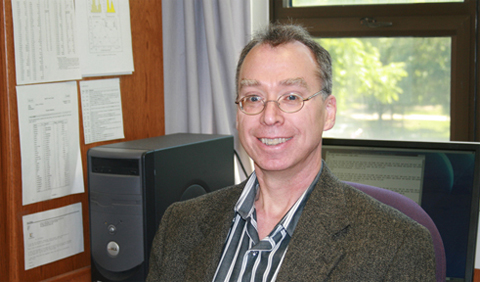Dr. Kenneth Hicks, Professor of Physics & Astronomy, was quoted in a Science magazine feature on “The social life of quarks.”
The article discusses particle physics observations of pentaquarks, “bizarre new cousins of the protons and neutrons that make up the atomic nucleus,” at the Large Hadron Collider at CERN in Switzerland.
In 2003, physicists thought they had spotted one: a pentaquark called the q+ (pronounced “theta plus”). Supposedly containing two up quarks, two down quarks, and one anti–strange quark, that particle was glimpsed by experimenters with the Laser Electron-Photon (LEPS) facility at the SPring-8 accelerator laboratory in Hyōgo Prefecture, Japan, which fired high-energy photons into a carbon target. Nine other experiments also reported the particle, which was thought to have a mass about 1.5 times that of a proton.
Then the q+ vanished. Other experiments found no sign of it, and some of the experiments that had seen it could not reproduce it. Physicists still aren’t sure how so many groups could be so badly mistaken, says Kenneth Hicks of Ohio University in Athens, who worked on one of the teams that originally saw the particle. “It was the strangest situation I’ve ever been involved in,” Hicks says, “and I was right in the middle of it.”…
NOW, LHCb researchers have confirmed the Belle tetraquark and reported strong evidence for two pentaquarks, consisting of two up quarks, a down quark, a massive charm quark, and an anti–charm quark….
BUT IF SUCH PARTICLES ARE REAL, how are they put together? Tetra- and pentaquarks could be bona fide bags of four and five quarks, respectively. Or both could be more like molecules made of two-quark mesons and three-quark baryons. Such binding would resemble that between the protons and neutrons in a nucleus, which is best described by the exchange not of gluons, but of quark-containing particles called p mesons, or pions. In fact, Karliner and Jonathan Rosner, a theorist at the University of Chicago in Illinois, have developed a model that they argue already explains most of the candidate tetraquarks and one of LHCb’s pentaquarks as molecules.
The molecule picture would also help explain why pentaquarks and tetraquarks, though fleeting, last a surprisingly long time. Physicists can’t measure that lifetime directly, but they can infer it from the uncertainty in a particle’s mass or its “width”: The narrower the width, the longer the lifetime. The tetraquarks and pentaquarks are narrower than physicists would expect for particles that can decay through strong interactions. A moleculelike structure could favor longevity, as it would sequester the quarks from one another and keep them from instantly forming new particles and falling apart. “There has to be some sort of barrier to the recombining,” Hicks says. “If they’re all in a bag, I don’t see what that barrier is.”
Read more in Science.

















Comments